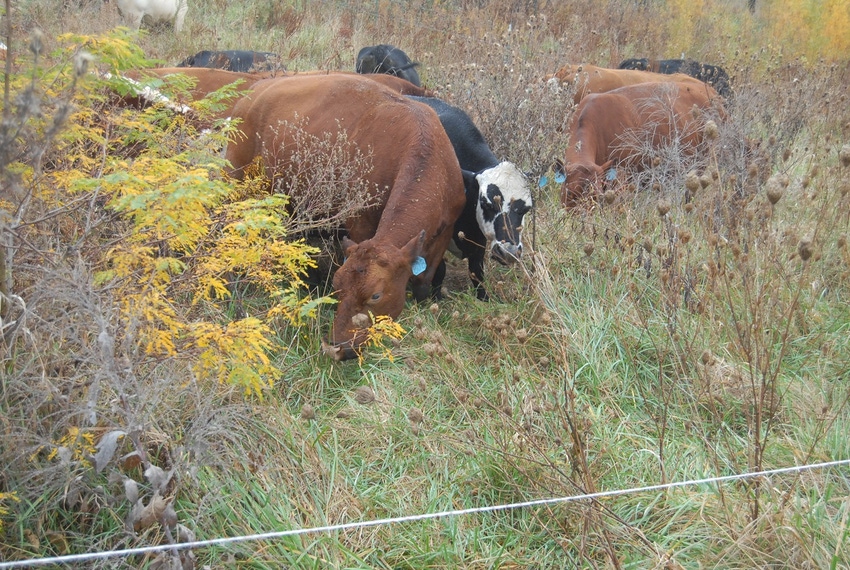
We're already past late summer, but that's the time we should have been well into planning for this winter.
When I was writing this blog in late July, it was the mid third-quarter of most people’s growing season. Moisture, sunlight, air and solar panels (leaves) are requirements for large forage growth. Calcium is the major mineral driver. Phosphorus is very important, as are potassium and magnesium. Several of the trace minerals include iodine, sulfur, copper, boron, selenium and salt deliver positive responses in higher moisture areas when added to the cattle or soil or both in small amounts.
Don’t forget salt (NaCl). One pound of salt per thousand pounds of body weight per week is a good place to start in most locations. Adding 1 pound of copper sulfate, 1 pound of iodide (EDDI-20,000mg/pound), 1 pound of selenium, and one-half pound of sulfur and boron to 70 pounds of salt and 30 pounds of soybean meal (SBM) is a good free-choice mineral for cattle in much of the country. It is also good for the soil. You can remove 20 pounds of the SBM and replace it with finely ground lime. A readily available source of phosphorus is 4 to 5 pounds of diammonium phosphate (DAP).
There are a few other things to review and think about when getting ready for winter. Here are five starters.
Loading and selling cows that are dry, it might pay to pregnancy check and mouth (age) them but chances are they need to go. The pregnancy checking and aging might help group them and increase their value a bunch. Remember that your culls might not be a cull to other producers.
Yearlings usually need to be gone by August 10. In some country this may need to be earlier.
Monitor all pastures both in front of and behind the cattle. Learn how to accurately figure cow days (which I consider to be 1,000 pounds of body weight per acre). By mid-August we should have enough forage to take our cattle into February. While the grass is still growing, a back-wire behind the cattle can buy you a couple of days on a regular basis and they will add up.
Body score the cattle. If they are not looking good in mid-July with scores of six or better they need help. July, August and September is a pretty easy time to add body condition cheaply.
It is a prime period to load cattle that are hard-keeping.
I realize that if I were living in Missouri or any other dry areas this year, then the above list should have been used and reused every 10 days or so since early to mid-May. Pulling the trigger a little too early beats the hell out of wishing you had later. Selling of yearlings and open cows a little early can grow a bunch of grass. Sometimes selling a little early should be more than a little early. Remember, I am not talking about destocking.
Planning, monitoring and executing Natural model knowledge and experience with completely recovered forage and high density short-term grazing has drought-proofed several operations. I am not talking about an untried experiment. Ray Banister in eastern Montana has been practicing most of these principals for more than 40 years. They work.
Now let’s return to the topic of wintering dry cows that are not dry. The truth is that fall-calving cows are wintered wet on most operations. With a few exceptions, the natural model does not calve cows in the fall and does not breed cows in late November, December, January or February. However, fescue and other cool-season forages, together with feed can and are continuing to drive such programs. The cost is always high and usually real high. Dry weather can take such programs out in less than six weeks.
Cows that calve in late May and June with lots of condition should breed in August and September. By October they are mostly still in lactation but milk production is greatly reduced. The truth is that sometime in February or early March these cows should have weaned their calves but it does not require as much energy to produce a pint of milk as it does to produce a gallon and a half.
We have successfully taken late-spring-born calves through the February-March period with their mommas. This is likely the natural model. Remember a little milk goes a long way for a calf 250 to 300 days old. But there are at least five major considerations.
Easy keeping, small cows.
Good cow condition in the fall (6+)
Lack of high lactation persistence (Hard keeping cows often have too much lactation persistence.)
Energy supplementation.
Lots of forage with plenty of plant diversity.
Yes, I know that mineral and water and weather protection are all critical. In our country mud is often a big issue. But I promise that mud is not the problem with 7- and 8-month-old calves that it is with babies. You don’t see many nasty teats on cows giving a pint of milk daily.
My major point or suggestion here is that we have for 10+ years grazed late spring-born pairs together all winter. Our forage is energy deficient, as is most everyone's. But we can supplement a little energy and reduce production cost tremendously while gaining market value and health and increasing ranch profitability.
Remember that we do not own equipment and are not going to. Remember that we like selling healthy yearlings. One of our aces in the hole is wintering “almost dry cows” with a calf at side.
About the Author(s)
You May Also Like






